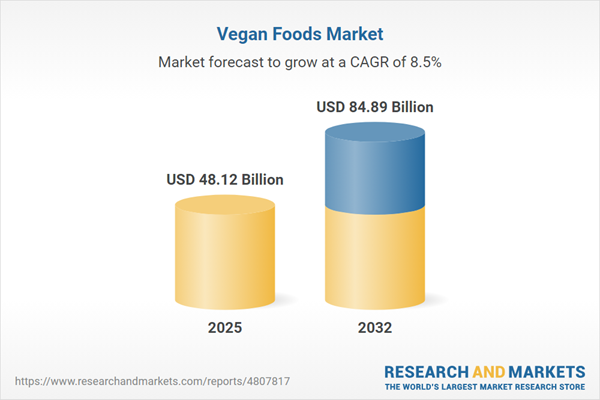Speak directly to the analyst to clarify any post sales queries you may have.
The global vegan foods market is rapidly evolving as organizations seek strategic ways to compete amidst shifting consumer expectations, stringent regulations, and ongoing product innovation. Senior leaders who proactively navigate these market forces can secure resilience and unlock new opportunities.
Market Snapshot: Growth Trajectory of the Vegan Foods Market
The vegan foods market continues to register robust growth as sustainability and health-conscious values reshape buying behaviors across consumer and institutional segments. Ongoing plant-based innovation, bolstered by advanced technology and supply chain fortification, fuels sector expansion. Legacy players and emerging brands invest strategically in their manufacturing, leveraging transparent practices to uphold brand reputation and comply with regulatory shifts. These efforts enable companies to maintain competitive positioning amid fast-paced consumer and policy changes.
Scope & Segmentation: Navigating the Vegan Foods Market
Strategic understanding of the vegan foods market’s scope and segmentation informs growth decisions and risk management. Each segment offers distinct commercial levers and adaptability potential:
- Product Types: Portfolio options span vegan bakery, confectionery, dairy alternatives, meat substitutes, plant-based snacks, and ready meals, broadening consumer reach and supporting demand trends across multiple buyer groups.
- Ingredient Sources: Almond, coconut, oat, pea, rice, and soy drive innovation and inform supplier risk strategies as ingredient scrutiny and sourcing volatility rise.
- Meal Occasions: Product lines for breakfast, main dishes, snacks, and desserts encourage responsiveness to varied regional preferences and occasion-driven consumption.
- Distribution Channels: Supermarkets, hypermarkets, convenience outlets, specialty retailers, direct-to-consumer, and online platforms deliver omnichannel engagement for optimized market access.
- End Users: Foodservice, hospitality, restaurants, and at-home customers require differentiated packaging and format adaptations that address operational and consumption differences.
- Geographies: The Americas, Europe, Middle East, Africa, and Asia-Pacific offer diverse regulatory environments and infrastructure, necessitating regionally tailored strategies for entry and operational scaling.
- Major Companies: Industry influencers including Danone S.A., Nestlé S.A., The Hain Celestial Group, Oatly Group AB, Impossible Foods Inc., Vitasoy International Holdings, SunOpta Inc., Daiya Foods Inc., GoodDot Enterprises, and Schouten Europe B.V. set pace in innovation and operational excellence.
Key Takeaways for Senior Decision-Makers
- Expanding plant-based portfolios is essential for maintaining brand relevance as health and sustainability priorities remain central to consumption patterns.
- Advanced manufacturing and processing technologies enable agility in production, supporting compliance and responsiveness to dietary and regulatory developments.
- Customization for region-specific cuisines enhances product acceptance and supports market entry in international territories.
- Risk-aware sourcing models and robust supplier relationships are key to ensuring reliable operations when faced with supply chain disruptions or shifting policies.
- Diversifying sales channels—across digital, direct-to-consumer, and physical locations—mitigates access risks and sustains operational flow amid shifting retail formats.
Tariff Impact: Navigating United States Trade Policy Shifts
Adapting to evolving United States trade policy is critical for companies dependent on ingredients like pea protein and coconut. Investing in domestic manufacturing and fostering regional processing capabilities can reduce exposure to international disruptions. Building durable partnerships with suppliers in stable regions ensures consistent product quality and supports long-term business continuity as regulations change.
Methodology & Data Sources
This market analysis is built on thoroughly vetted peer-reviewed studies, regulatory reviews, and targeted executive interviews across procurement and supply chain roles. Every insight is validated by structured, multistep processes to maximize relevance for executive planning and operational decision-making in the vegan foods market.
Why This Report Matters in the Vegan Foods Market
- Empowers executives to proactively identify plant-based growth opportunities and effectively manage volatility in a changing foods landscape.
- Delivers actionable perspectives on regulatory and technological trends, equipping leaders to build adaptive and forward-thinking strategies.
- Supports informed portfolio diversification and agile resource allocation as product lifecycles and consumer requirements evolve.
Conclusion
Innovation, regulatory alignment, and robust partnerships position organizations to achieve sustainable growth in the evolving vegan foods market. With careful operational planning, businesses are poised to adapt as consumer and policy landscapes shift.
Additional Product Information:
- Purchase of this report includes 1 year online access with quarterly updates.
- This report can be updated on request. Please contact our Customer Experience team using the Ask a Question widget on our website.
Table of Contents
3. Executive Summary
4. Market Overview
7. Cumulative Impact of Artificial Intelligence 2025
Companies Mentioned
The companies profiled in this Vegan Foods market report include:- Danone S.A.
- Nestlé S.A.
- The Hain Celestial Group, Inc.
- Oatly Group AB
- Impossible Foods Inc.
- Vitasoy International Holdings Limited
- SunOpta Inc.
- Daiya Foods Inc.
- GoodDot Enterprises Pvt. Ltd
- Schouten Europe B.V.
Table Information
| Report Attribute | Details |
|---|---|
| No. of Pages | 197 |
| Published | November 2025 |
| Forecast Period | 2025 - 2032 |
| Estimated Market Value ( USD | $ 48.12 Billion |
| Forecasted Market Value ( USD | $ 84.89 Billion |
| Compound Annual Growth Rate | 8.4% |
| Regions Covered | Global |
| No. of Companies Mentioned | 11 |









